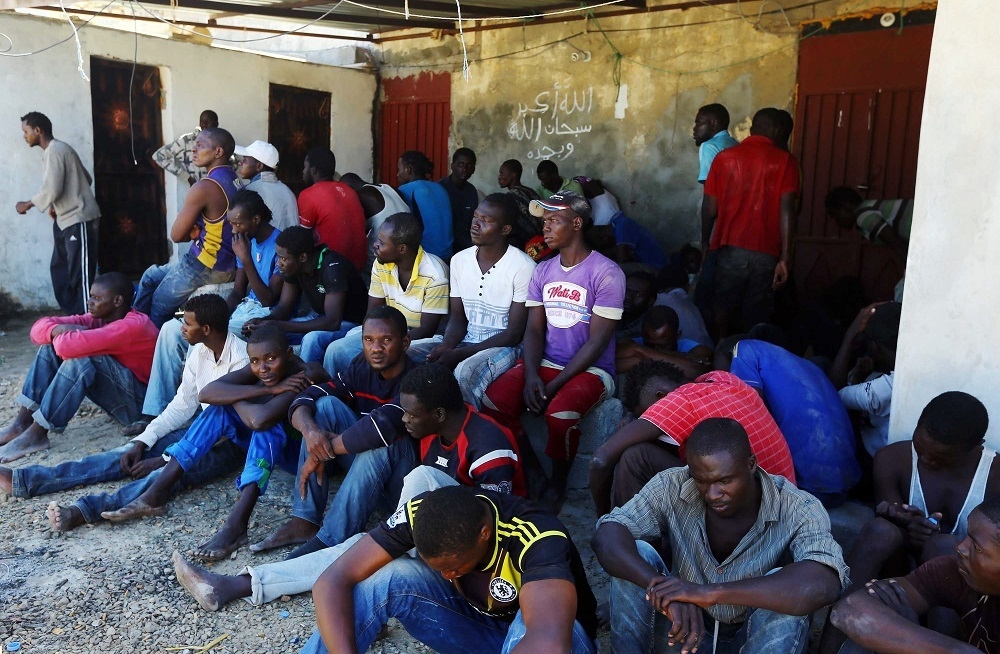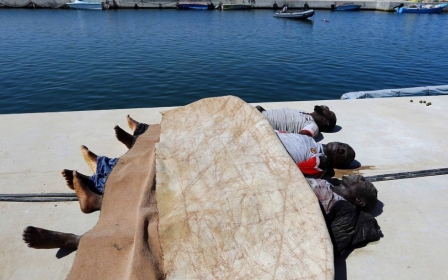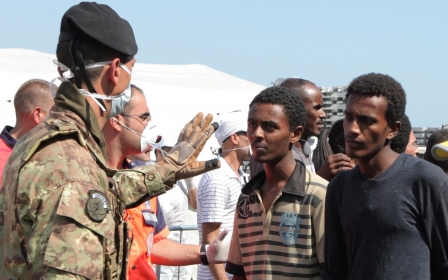Libya's human traffic boom

SEBHA, Libya: Mohammed stands with the other young men hassling Libyans in passing cars for work in the neglected downtown area of the southern Saharan city of Sebha.
Mohammed, a 19-year-old former soldier from Gambia, is one of hundreds of sub-Saharan migrants scrambling for money in this inhospitable human trafficking hub on the road to the Mediterranean coast.
They will shell out for another 700-kilometre trip headed north through the scorched and dangerous desert, and then there is the €1,000-plus boat ride through hazardous winter seas to Italy or Malta.
“They kidnap people often,” Mohammed said, gesturing towards the men around him. “Most men here have been kidnapped for ransom.”
In Mohammed’s case, a pick-up truck packed with 29 migrants crossed the Libyan border with Niger and dumped them in the desert. Soon after, they were picked up by militiamen, who drove them to an isolated farm, beat them for more than five days and demanded a ransom of €600 each to buy their freedom.
Mohammed said one evening he and some other former soldiers from Gambia managed to overpower their captors, free the other migrants, and drive until Sebha. There they scattered into the night.
Lucrative trade
Since Libya’s revolution in 2011, rule of law institutions and security in the North African state have disintegrated, leaving a patchwork of militias and detention centres, many operating outside state control.
The lucrative trade of trafficking humans, oil, food, goods, drugs and weapons across Libya’s porous southern borders with Niger, Chad and Sudan has increased, and so have the rudimentary wooden boats rides across the choppy Mediterranean sea.
Men and women from West and East African countries headed to Europe find themselves funneled up the coast through Libya. They are often arrested, robbed, beaten and, in the case of women, raped, or sent back to the country they have fled.
“The situation has been exacerbated by the armed conflict in Tripoli,” said Hanan Salah, a researcher for Human Rights Watch. “The situation in Libya has deteriorated so drastically in the East since May [this year], and [it has also deteriorated] in Western Libya since July, that they [migrants] are more at risk than ever.”
Mohammed Suleiman from Niger is not sure what age he is, but he believes he is 23. Dressed in a soiled Qatar football shirt, he described how he hauled sand on a construction site for hours the day before, only to have a man with a gun take his money.
Suleiman shares a room with 60 other men, for which he pays €33 a month. His friend Mohammed’s chaotic building is in the al-Jadeed neighbourhood, which houses 900 men; prostitution and gambling is rife, and the building is tightly controlled by armed militia.
“It’s another world,” said Mohammed.
While most of the men lining the shabby streets each morning dream of reaching Tripoli, Suleiman has already been there, and has just been sent back. “They came to where we were staying at midnight,” he said.
“They took us to a detention centre, robbed us of money and clothes, and brought us back to the border with Niger. It was a ‘government’ militia doing this. They told us if we paid them 200 Libyan Dinars [€133] we could buy our freedom.”
This year the number of migrants from Libya reaching Europe by sea are staggering.
From January to October the United Nations High Commissioner for Refugees (UNHCR) has documented 154,000 people who arrived by boat to Italy, with about 130,000, or 85 percent, leaving from Libyan shores. The vast majority are refugees fleeing deadly wars in Syria and Eritrea. More than 40,000 migrants took the same route the year before.
When the fighting kicked off this year in Benghazi and Tripoli, the monthly numbers tripled. Although there were up to 7,000 migrants being held in detention centres before the hostilities, the number departing in boats was at least four times as much.
In response to the devastating shipwrecks off the Italian island of Lampedusa last year, which left more than 400 dead, Italy announced its Mare Nostrum search and rescue operation in international waters. The programme, which cost around €9 mn a month, was responsible for rescuing an estimated 150,000 migrants attempting to reach its shore.
There has been an estimated 3,000 deaths at sea this year.
Italy’s policy towards migrants has been criticised by northern European countries, which claim migrants use Italy only as a transit country to travel north to settle. The EU withheld funding for the humanitarian effort and, last month, Italy agreed to end Mare Nostrum.
Human rights organisations have been quick to react to last month’s decision to replace the humanitarian program with a broader EU-funded Triton operation, run by Frontex, with ships patrolling much closer to the European shoreline as border guards.
“Over this summer’s boat season we have seen the highest numbers of deaths at sea than we have ever heard of,” said Hanan Salah. “If there is no one who is actively searching, the situation can only become worse for these refugees and asylum seekers.”
Criminal networks
With Libya split between two governments and parliaments – one based in Tripoli and Tobruk – there is little hope that the situation will calm down any time soon.
As the fighting - mostly between tribes over resources and power has roiled the west, east, as well as the south - there has been little attention, funding, training or capacity to police and maintain Libya’s vast borders and detention centres, and tackle criminal networks.
There is not a political strategy like Gaddafi’s, where he manipulated migrant flows to Europe,” said one western diplomat. “Migrants now mean money, and there is a clear interest of the local communities to participate.”
“Now, 10 percent of Libya’s general product relies on human trafficking, smuggling subsidised goods, weapons, and drugs,” he continued. “So of course there is another issue. You have part of the population that is completely against the normalisation of the country because they have no economic interest in it.”
In the mostly deserted detention centre outside of Misrata, one man lies sick with HIV, while another Egyptian man, Mohammed, says he has been diagnosed with Hepatitis C, and claims that the authorities won’t let him out despite his valid papers. The halls are filthy, and one woman that the guards call “crazy” has staked out a corner room full of garbage to rest.
“Detention facilities are formerly run by the Libyan government, but most of them are run de facto by local groups and militias,” said Salah.
“The conditions in them are horrific, I have rarely seen such bad conditions for human beings. The treatment of these migrants is horrific as well - they complain of torture, whipping, and food deprivation.”
Masaad Ragoubi, the head of Libya’s Department to Combat Illegal Migration, said that during this summer’s fighting around Tripoli International airport, they had to empty most of their 19 detention centres and send people back home.
“Now our centres are not up to international standards - it’s not like Europe,” Ragoubi said, while stressing that he was hoping for a stable government budget next year.
“Before the revolution, the government provided prisons for immigrants, who had to buy food for themselves. Even they would have to pay their own way back home. But now we are paying for shelter, food and sending them back.
“We pay millions a month for food and other services,” he added.
With Europe deeply reluctant to allow in more migrants though, this unwanted arrangement looks likely to continue.
“After Mare Nostrum we were asking refugees and migrants, what is the lure? Why are you going?” said UNHCR officer Dunnapar Fern Tilakamonkul. “They said if we were able to legally stay and work in Libya we may not want to go. But Europe is the destination and we are seeking safety.
“Nobody reports back on the conditions once they arrive,” she said. “I don’t think people see that it is actually a long struggle after you arrive … Once you arrive there is pressure to show that you have done well.”
Mohammed in Sebha just nods when he hears about the challenges of living in Italy.
“Everyone here wants to go to Europe,” he said. “I have friends inside camps in Rome, and they tell us that people are dying on the sea. I heard they may not rescue boats anymore,” he said. “But it doesn’t matter - I want to go.”
New MEE newsletter: Jerusalem Dispatch
Sign up to get the latest insights and analysis on Israel-Palestine, alongside Turkey Unpacked and other MEE newsletters
Middle East Eye delivers independent and unrivalled coverage and analysis of the Middle East, North Africa and beyond. To learn more about republishing this content and the associated fees, please fill out this form. More about MEE can be found here.




